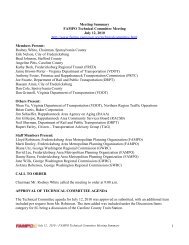Projections Dataset and Methodology
Population and Employment Projection Dataset and ... - FAMPO
Population and Employment Projection Dataset and ... - FAMPO
- No tags were found...
Create successful ePaper yourself
Turn your PDF publications into a flip-book with our unique Google optimized e-Paper software.
Forecast data is released annually, in October. The forecasts used in this report were released in<br />
October 2010. Given the release date, the current W&P forecasts are almost a year old <strong>and</strong> do not<br />
appear to capture the economic trends nor does it incorporate the latest US Census data. Generally this<br />
is not an issue; however, this year it is somewhat of an issue because (1) of the volatility of the US<br />
economy (where forecasters are continually revising short term growth projections); <strong>and</strong> (2) the release<br />
of 2010 census numbers would replace the current estimates for 2010. It is widely anticipated that with<br />
this release of actual census data, W&P would decrease its population estimates for 2020, 2030 <strong>and</strong><br />
2040.<br />
Forecasts are relatively inexpensive to purchase.<br />
Global Insight: these economic <strong>and</strong> demographic forecasts are developed by IHS Global Insight (GI), a global<br />
forecasting firm that provides forecasts covering over 200 countries <strong>and</strong> spanning more than approximately 170<br />
industries. Gl is considered one of the premier forecasting firms, <strong>and</strong> is consistently rated as one of the most<br />
consistently accurate forecasting firm (see http://www.ihs.com/products/global-insight/accolades.aspx for recent<br />
accolades on forecasting accuracy). Unlike W&P, GI’s methodology is somewhat of a ‘black-box’ <strong>and</strong> documentation<br />
is not readily available. Some key characteristics of the forecasts are described below.<br />
Comparisons<br />
1. Population forecasts are available at the county level for years 2010, 2020, 2030, <strong>and</strong> 2040.<br />
Unlike EMSI <strong>and</strong> VEC forecasts, the GI forecasts could be used in the LRTP without any extrapolations.<br />
2. The cohort-component method is used for population forecasting (i.e., use a combination of birth rates,<br />
death rates <strong>and</strong> migration to forecast population).<br />
3. Similar to W&P, the ‘dem<strong>and</strong>’ for total population s estimated from the economic model; <strong>and</strong> as such,<br />
population (i.e., in-migration) is a function of the regions employment potential.<br />
4. GI forecasts are consistently updated; <strong>and</strong> as such reflect the most recent market trends <strong>and</strong> data<br />
updates (such as 2010 US Census data). Our ability to access GI forecasts on a real-time basis (via our<br />
online subscription) allows us to provide GWRC/FAMPO with the most up-to-date forecasts.<br />
5. GI methodology is a hybrid between the employment methodologies of the Bureau of Labor Statistics<br />
<strong>and</strong> Bureau Economic Analysis, which makes it harder for practitioners to underst<strong>and</strong>.<br />
6. One-time purchase of these forecasts is expensive; <strong>and</strong> could provide a significant cost burden on to the<br />
project.<br />
The following exhibits provide comparisons of the four forecasts discussed before (i.e., EMSI, VEC, W&P, <strong>and</strong> GI).<br />
As illustrated in Exhibit 2, of the four forecasts, EMSI is an obvious outlier. As highlighted in the previous section,<br />
EMSI forecasts seem to have several methodological discrepancies. Unless these discrepancies are resolved (by<br />
obtaining further documentation <strong>and</strong> access to supporting models), it is our recommendation that EMSI forecasts<br />
should not be considered as a c<strong>and</strong>idate for use in the LRTP.<br />
VEC forecasts for 2010 seem to be higher than US Census estimates, <strong>and</strong> that difference (approximately 17,000,<br />
which translates to a 5% overestimation) appear to permeate through to the entire forecast. Given this<br />
overestimation, we do not recommend the use of VEC forecasts in the LRTP.<br />
The remaining two forecasts (W&P <strong>and</strong> GI) appear to widen over time (W&P is 8% higher than GI in 2040). Both<br />
W&P <strong>and</strong> GI are reputed independent third party forecasting firms, which have no observable methodological flaws.<br />
FAMPO 2040 Long-Range Transportation Plan: Socio-Economic Data Element 31



